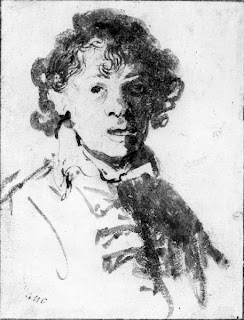The first self portrait I did in soft pencil - does it look like me? Kind of! There are aspects of all three that look like me, and aspects that aren't right at all. In the first my face looks too narrow at the chin area and my hair too short. The second portrait I decided to do looking down my nose at myself which was an interesting angle and actually quite tricky, but out of all three it probably looks most like me... I noticed while doing these portraits that I purse my lips when I'm drawing, something I was not aware of at all until now! The third portrait I did for fun more than anything - I wanted to see how I would cope with pen and ink. It's not as dramatic or telling as it could be and the eyes are too large, but like I said before there are aspects of it that are fairly accurate - like the shape of my hair around my face and those ridiculous pursed lips!

I asked my boyfriend Paul to comment on the three drawings - he agreed with me that the second drawing (the one looking down my nose) looked most like me but said my features looked a little too pinched. The third drawing he said looked like a haggard me in 40 years! But he said it might be because of the way I've hatched with the pen ink - it looks like wrinkly skin. The first drawing we both realised together that there is too much face and not enough head - I added a little more to the drawing while we talked and already it looked far more realistic. See below.
The preliminary drawings were more helpful than I could have imagined, and really urged me to be a bit more experimental - I think I need to let go of my fear of producing something s**t and just go for it. The sketches in my sketchbook pave the way for feeling freer with the larger scale work. They enable you to take those scrappy bits of ideas and details and turn them into something more interesting. (This idea, I know, still needs work and I'm determined to come out of my shell...)
The portrait from memory was unbelievably hard! I was shocked by how difficult it was to remember the features of my long term boyfriend who's face I see every day! It took several sketches to get those features anyway nearly there and even then the 'finished' portrait is still not Paul... But it's a really interesting exercise because it teaches you to dive into your imagination, and not rely on what simply is front of you. (I just hope Paul never sees his portrait or he'll surely cry!)











































